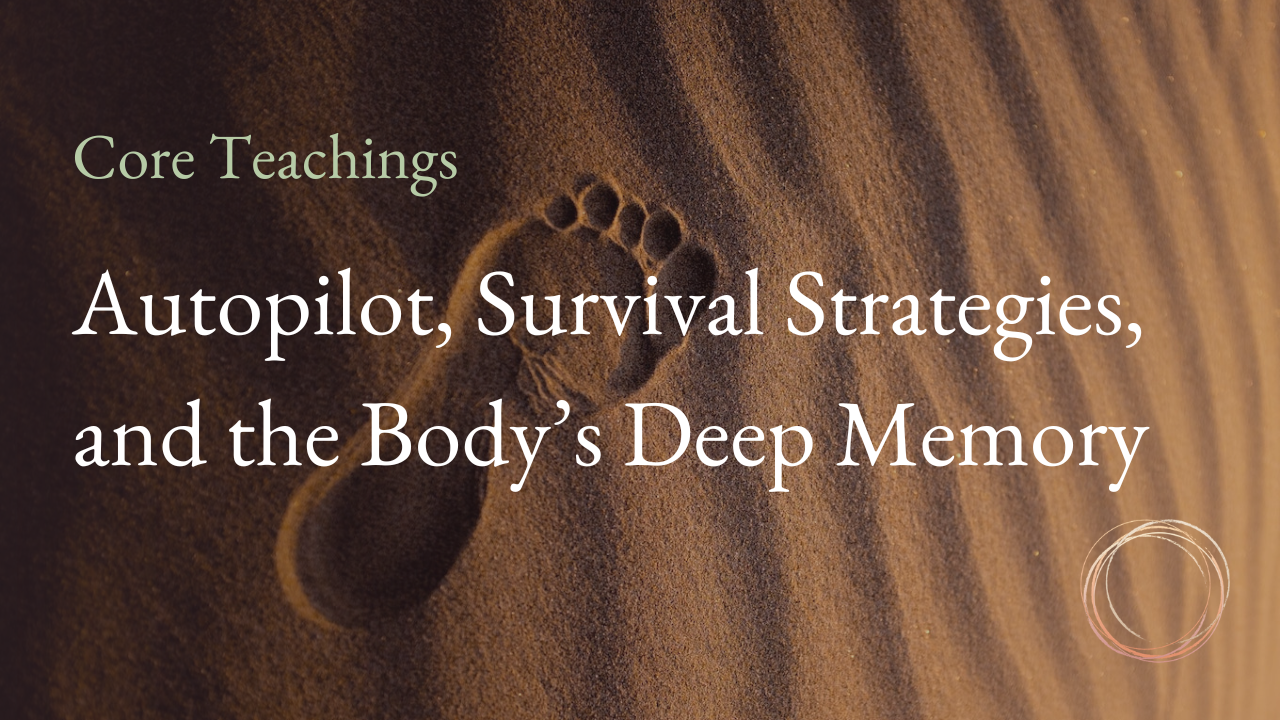Autopilot, Survival Strategies, and the Body's Deep Memory
Sep 15, 2023
According to the map of the Window of Tolerance, there is an optimal activation zone where we are feeling a sense of somatic safety, with all the features that brings: we are present and responsive, with our higher cognitive faculties online, and can think and feel and act proportionately according to the situation.
But outside the zone of optimal activation are the states of HYPER and HYPO activation.
These states are our evolutionary inheritance, the deeply embedded survival strategies encoded into our nervous system over millions and millions of years.
But more than being simply biological mechanisms, we experience them in our lives as the particular strategies we revert to when triggered.
These particular strategies are the unique ways that we as individuals learned to survive when things got really rough in the past.
They are behaviours that worked in situations we experienced as dangerous or life-threatening, which then got laid down in the body, and are now automatic and unconscious.
Some examples of these kind of situations might be when:
…your mum left you alone for a couple of minutes when you were a tiny baby, and you didn’t know if she was ever coming back…
…or when you were ridiculed at school for something you said or did in class…
…or when you were in a potentially fatal accident or incident…
…or when someone you deeply loved left you, and it felt as if loss and grief were a wild tiger mauling you and at any moment could deliver the final crushing blow…
All these things and countless others can register on the nervous system as life-threatening situations, and kick the body into survival mode.
And whenever this happens, patterns are laid down deep in the body and become part of the instinctual self.
And it is these patterns which form into the survival strategies we drop into when we become triggered.
They then live outside our window of tolerance, waiting to protect us from harm whenever needed.
This is the idea of ‘procedural memory’.
Autopilot
Patterns of action become procedural memory when learned behaviour has penetrated into the deeper, unconscious layers of the psyche, and when activated starts playing out on autopilot.
But it is important to note that we have all sorts of procedural memories, most of which are really useful.
When we learn to ride a bike it becomes a procedural memory – we don’t have to think about doing it anymore, we can just do it.
Same with tying our shoelaces, or typing on a keyboard.
Procedural memories tend to serve us well.
But when it comes to those laid down in traumatic situations, it’s more complex.
Yes, they may have served us well at the time –
…crying out until mummy comes back is a pretty decent evolutionary strategy for a baby who has no other way to draw attention to itself…
…maybe going very quiet in school and trying not to draw any kind of attention to yourself felt like it kept you safe from further humiliation…
…jumping out of the way of that motorbike that was hurtling towards you probably saved your life…
…and closing down your heart and numbing out emotion might have reduced the pain of losing your loved one…
– but when our nervous system applies these procedurally learned behaviours to events taking place in the present, there is often a serious mismatch between the present situation and the survival strategy which gets activated in response.
Mismatched Responses
A couple of examples of mismatched responses:
When we are within our window of tolerance, we can see that breaking down and crying uncontrollably when our partner requests a little space isn’t an appropriate response to the situation.
But when we are triggered, we have no access to the reflective, relational self that can see that.
We are in the grip of a survival strategy laid down long ago when mummy disappeared and we didn’t know she was ever coming back.
Similarly when we go into collapse when faced with a public speaking event – maybe shutting down and going invisible worked when we were a child afraid of further humiliation, but it’s not an appropriate or useful response to the present situation.
Transforming Procedural Memory
Navigating these kinds of mismatches is why the map of the window of tolerance and the toolkit of somatic resources is super helpful:
- We can learn to recognise when we’re triggered
- We can notice that we’re acting out a procedural memory on autopilot, and
- We can then apply techniques to bring ourselves back within the window, where we have access to a wider range of responses and more freedom to choose how to act.
Additionally, this understanding lets us have compassion for our triggered self.
The behaviours which manifest when we are activated were laid down at difficult moments, and were our best attempts at that time to keep ourselves safe.
And since we’re still here, they probably worked!
So it’s understandable that our body’s intelligence draws on these survival strategies in moments of perceived danger.
But our job now is to help the body to learn new, more appropriate strategies.
Doing so isn’t difficult, and can even be fun and delicious!
That’s how we approach this work at Embodied Intimacy anyway, bringing a mixture of respect, compassion, and serious playfulness to what we teach.





